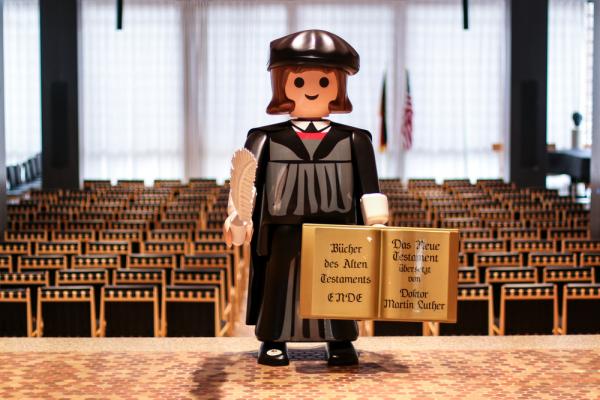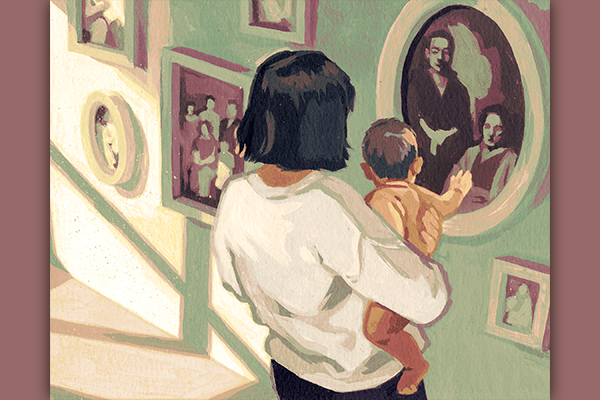The iPhone was history’s eighth greatest invention, narrowly losing out to penicillin, said 4,000 Britons surveyed in 2010, according to the Telegraph. The wheel ranked first, which makes sense — think about all those Far Side cavemen cartoons — but the internet, PCs, and the telephone made it on the list, too.
The printing press and movable type didn’t even crack the top 100. But an iPhone without the ability to read would be like a survey without proper statistical framework — and the fact that many think contemporary technologies like social communication channels or portable reading devices are such transcendent “disrupters” that they belong in the conversation of history’s greatest inventions is telling.
Part of the difficulty here is to imagine how radically different things were in Europe half a millennium ago. Today, regardless of profession or income bracket, we are bombarded with text. But in 1517, still the early days of movable type, text wasn’t nearly ubiquitous — in large part because most people couldn’t read.
Yet in Germany, a 33-year-old monk named Martin Luther rapidly disseminated a series of radical, reform-minded writings — so successfully, in fact, that it puzzled even him.
“The only way he could explain it was, as usual, by God,” Craig Harline, a Brigham Young University history professor, wrote in his book A World Ablaze: The Rise of Martin Luther and the Birth of the Reformation.
“For some reason, [God] had thrown Dr. Martin ‘into this game’ of spreading the gospel not just by mouth but in print.”
What explains Martin Luther’s success, in a time before reading was widespread?
Luther’s sermons were “stunningly concise and clear,” Harline wrote. But the monk also owed a good deal to the care he put into the physical appearance of his books. Luther relied on a Wittenberg printing shop for engaging fonts, and renowned artist Lucas Cranach the Elder, who lived down the street from the Luther’s friary, provided the illustrations. (And lest one think today’s political discourse is unusually toxic, one of Cranach’s illustrations, of Luther preaching as a pope conspicuously burns in hell, ought to dispel that misconception.)
“In the absence of precise literacy rates, it’s safe to assume only a small minority could read, or probably needed to read,” Harline said in an interview. “By Luther’s time, rates have been put at around 5 to 10 percent for all German lands, and maybe 20 percent in towns.”
In many ways, Cranach’s illustrations harnessed the rising demand for religious books. Luther’s ideas spread overwhelmingly by word-of-mouth. Rather than poring over the texts by candlelight, the faithful heard pastors read Luther’s ideas from the pulpit, or caught summaries of those readings from drinking buddies in taverns. “Most people almost certainly heard the writings, and didn’t read them,” Harline said.
And they looked at the illustrations, which told a simple, dramatic story.
Luther's first bestseller, A Sermon on Indulgences and Grace, sold 24,000 copies in the first two years, according to Harline. That’s massive, he noted — but one also has to multiply that number exponentially by the number of times it was read publicly.
It’s instructive, if somewhat imprecise, to think of that reach in terms of social media today.
Although the printing press and its use of metal type had been invented some 70 years prior to the Reformation, Luther learned how to use it to appeal directly to a public which had previously been insulated from controversial religious topics, according to Euan Cameron, an Episcopal priest and professor of Reformation church history at Union Theological Seminary.
“His re-use of printing could be compared, for example, to a medium, originally being designed for scientists to share ideas electronically within the academy, suddenly becoming a means for any and everyone to share and receive ideas,” Cameron said.
“Many editions of his works were produced as commercial works by publishers outside his orbit who made a profit by exploiting his celebrity and the fact that he wrote so well.”
The printing press created the “preconditions” for Luther’s and Cranach’s success, according to Cameron, and Luther was the first to realize the medium’s potential for disseminating accessible, religious literature. Cranach brought his “remarkable” skills in the graphic arts and his business acumen to helping “guide Wittenberg into a place where it was far more important commercially than before,” Cameron said.
And Luther himself carried commercial potential. “The image of the lone friar, hammering his propositions to the church door, exercises an understandable appeal,” Peter Marshall, a University of Warwick history professor, in 1517: Martin Luther and the Invention of the Reformation wrote. Though the event “most likely never took place at all,” Marshall wrote, “…It is a gesture that seems at once assertively public and honourably private.”
Put another way, Luther's is the story of “how an obscure university professor developed a commercial identity through skillful exploitation of the high-tech media of his day,” Richard Rex, professor of reformation history at University of Cambridge, wrote in The Making of Martin Luther.
Some scholars of Christianity claim that more has been written on Luther than anyone but Jesus himself, and BYU’s Harline is inclined to believe it.
“Among the general population, it’s surprising how many have heard the name Luther, but also how few know what he actually did, which is often the case with larger-than-life figures like him," Harline said.
The notion of Luther affixing his theses on indulgences to the church door has been romanticized, according to Harline.
“He decided to make his views known, first by preaching, but then also by doing what professors did: writing theses for a disputation. He did that all the time,” Harline said. “He and other professors posted theses on the university bulletin board, which happened to be the door of the university church. Other announcements were on that door, too— so posting theses had all the drama of a professor stapling something up in the student center.”
Not only was the act not dramatic, but Luther probably didn’t post these theses on Oct. 31, 1517, because indulgences were still too sensitive a subject at the time, according to Harline.
“Yes, it was an unsettled subject, and so in theory he had the right to hold a disputation on it, but in practice most professors avoided the subject because of who was in charge of it — the pope himself,” he said.
On Oct. 31, Luther did send a letter to some friends and several bishops, and soon those theses were printed, and even translated to Latin and German. That angered Luther, who didn’t want to criticize the pope, according to Harline.
“People didn’t understand the culture of disputation, with its exaggerations and attacks — and [Luther worried] they might also think he was somehow against the pope!” Harline said. “That was when he wrote his much more popular German Sermon on Indulgences and Grace, to tell people, in about 20 theses, what they really needed to know — and there wasn’t one word against the pope.”
Therein lay a frustration for Luther, who would have preferred to be associated with the argument for justification by grace through faith alone, rather than the German appetite at the time for anti-papal writings.
“Many took his message and used it in their own ways, which helped make it a mass movement, and also got him in trouble,” Harline said, in a nod to misinterpretation and appropriation that abounds on social media in the 21st century.
The criticism would snowball, though, and Luther eventually arrived at a place where he did criticize the pope’s authority over the church altogether, with Cranach’s illustrations of popes in hell in playing a supporting role.
Still, 500 years later, Cameron, as a priest, finds Luther’s basic message compelling: “That the love of God does not require us to engage in all kinds of excess spiritual ‘activities’ in order to become ‘pure’ or holy enough,” he said.
“On the other hand, someone conscious of the love of God will and should share that love with others.”
And another enduring message can again be compared to the social media landscape of today.
“Luther’s story matters, because it shows that a message can become much bigger than the person who first spreads it around. Ideas have an energy of their own,” Cameron said, noting Luther’s writings also charted problematic territory, as when they peddled anti-Semitism.
“Part of the importance of his story lies in the fact that the message was bigger than the individual.”
Got something to say about what you're reading? We value your feedback!







